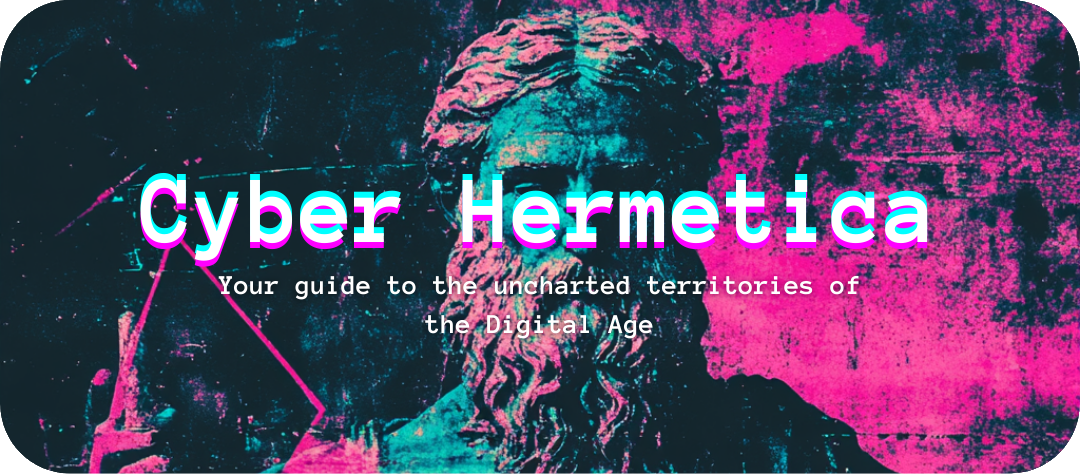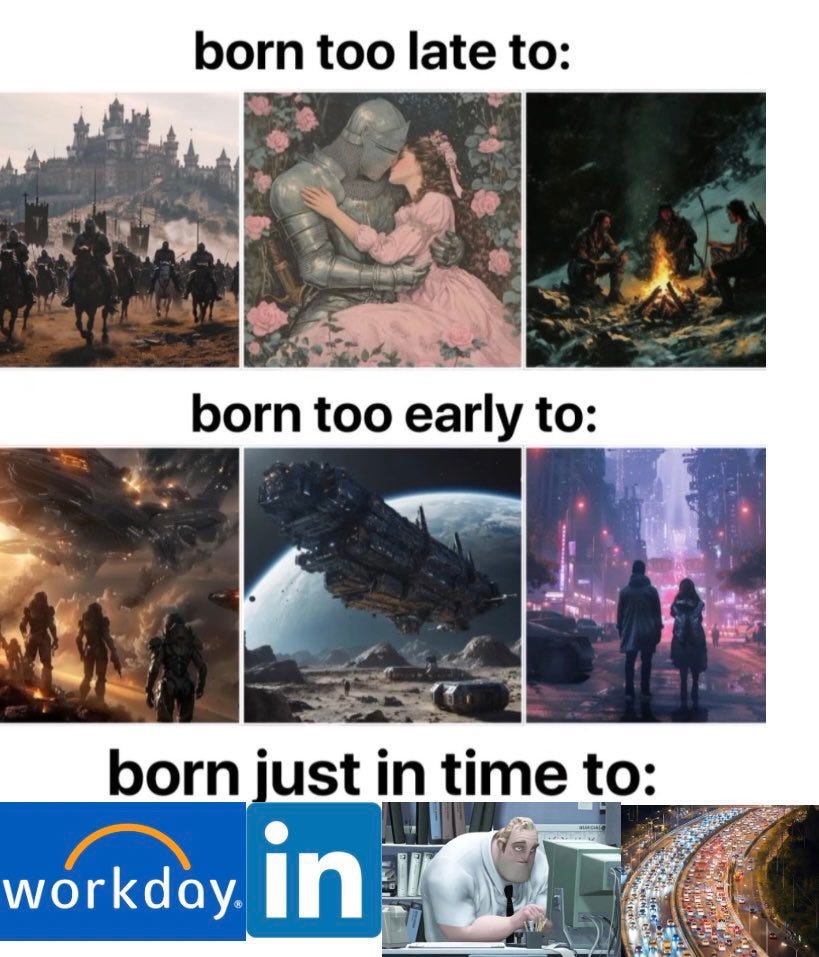Hi there, I’m Matte. Privacy & cybersecurity professional by day, schizo-cyberoccultist by night. Every sunday I bring you a weekly dose of schizophrenization, blending insights into the Digital Age, echoes from the past and digital survival tips. If you like this, you will also enjoy the rest of Cyber Hermetica!
⚡ SEMIOTIC FLASHES
Personal weekly considerations. Decrypting meaning, one flash at a time.
The Genie is already out of the lamp
Imagine a world where androids walk among us—silent presences gliding through our homes, toiling away on production lines, and standing faceless among the ranks of law enforcement.
Humanoid robotics has hit the accelerator. Day by day, startups and major corporations envision new prototypes of cybernetic beings capable of walking, squatting, sitting, manipulating objects both large and small, and even possessing the gift of touch. NEO Gamma, Figure Helix, Unitree G1, GR-2, Pudu-D9, Protoclone V1—these are just some of the models currently in development worldwide. Electronic creatures moving with fluid precision, thinking machines, and even androids equipped with artificial skeletons and muscles, like something straight out of Westworld.
Will robotics and artificial intelligence mark our rebirth or our downfall? Are we heading toward a utopian or dystopian future? Opinions diverge. According to Elon Musk, humanity is about to witness a new golden age:
A magic genie that grants you everything you want, with infinite wishes, is both a blessing and a curse. We will have a universal high income—everyone will truly have access to that magic genie. It will be the age of abundance—but how do we find meaning in life if a genie can fulfill our every desire?
When artificial intelligence replaces white-collar jobs, and robots take over blue-collar work, what will be left for us? Musk argues that we will reach a point where no human job will be truly necessary—one could still work for personal fulfillment, but AI will be able to handle everything.
Yet, when AI and androids take over human labor, will it truly be paradise on Earth, or an age of abundance reserved for the few? Again, the answer depends on one's perspective. Some believe that the rapid acceleration of technology will benefit only those who already possess immense financial resources and vast computational power—a narrow elite that, with armies of androids and super-intelligent AI, could control the vast majority of global resources.
Masses, stripped of economic relevance, might become obsolete remnants of history, relegated to the margins. A cyberpunk dystopia is easy to imagine: international oligarchs, safe within their hyper-technological strongholds, while the rest of the population is confined to enclaves with no escape, condemned to absolute poverty and a rapid demographic decline. In the end, these new gods of Olympus may claim the entire world for themselves.
On the other hand, optimistic accelerationists see an opportunity to finally establish a universal high income—a generous basic income allowing everyone to live comfortably without working, made possible by the abundance generated through AI and robotics. The idea isn’t absurd: if machines truly replace the majority of human labor, social paradigms, economic models, the very concept of the state, and taxation must be redefined—robots aren’t paid, and therefore, their labor cannot be taxed.
As always, when it comes to technology, the crucial issue is control. The difference between a utopian future—where we can pursue our true nature without working for survival—and a dystopian one, where cybernetic resistance and guerrilla warfare emerge over resource control, lies in who holds the power. That’s why it is essential, from now on, that AI and robotics remain accessible and widely understood—not just by Elon Musk and technocrats, but by ordinary people like you and me.
💻 DIGITAL GRIMOIRE
Digital survival tactics: OpSec, Cybersec, OSINT, and AI tools to dominate the Digital Age.
Anatomy of a prompt
Last week (#12) we talked about the anatomy of a prompt. How to write one with a clear and effective structure. Today, we’ll delve into the science of prompting techniques.
The science of prompting is the key to obtaining increasingly precise and useful responses from artificial intelligence. A well-crafted prompt doesn’t just ask for information—it guides the AI’s reasoning process.
There are various strategies for interacting with AI, each with its own advantages depending on the context. Today, we will explore Zero-Shot Prompting, a technique where the model responds to a request based solely on a single instruction, without additional context. This approach is particularly effective for direct tasks or factual questions, but it can be further refined using specific techniques:
Role Prompting: Assigning the model a role to shape the tone and content of its response.
Example: "You are a cybersecurity expert. Explain what a phishing attack is and how to defend against it."
Style Prompting: Specifying a particular style for the AI’s response.
Example: "Rewrite this text in noir style: ‘It was a dark and stormy night…’"
Emotion Prompting: Directing the AI to convey a specific emotion.
Example: "Write an enthusiastic response to a travel proposal for Tokyo."
System 2 Attention (S2A): Encouraging the model to reflect before responding.
Example: "Think carefully: if a train departs at 10:00 AM and arrives at 1:30 PM after three stops, how long does each segment last if they are equal?"
Re-reading (RE2): Instructing the model to review a text before generating a response.
Example: "Carefully reread the following message before analyzing it: ‘The customer is requesting a refund but has lost the receipt. How should we handle this situation?’"
The main advantage of Zero-Shot Prompting is its speed—the model generates responses without needing additional context. However, for more complex tasks, it may prove insufficient.
In an upcoming premium subscriber-exclusive article, I will dive deeper into advanced prompting techniques, such as Few-Shot Prompting, Chain-of-Thought (CoT) Prompting, Decomposition, and Self-Criticism, which allow for more structured and reliable AI reasoning processes.
Don’t miss it!

📡 DIGITAL SIGNALS
Transmissions from the infosphere: world events, data breaches and news that impact our digital reality.
More than 400.000 ETH stolen. February 21, 2025, will go down in history as the day the largest cryptocurrency exchange hack ever recorded took place—perhaps even the most profitable one (for cybercriminals) in nominal value. A staggering $1.5 billion worth of Ethereum was stolen from the Bybit exchange.
The attack was carried out by Lazarus Group, the notorious North Korean cybercriminals already wanted worldwide for numerous high-profile hacks. As of today, they hold 0.42% of the world’s total Ethereum supply—more than the Ethereum Foundation itself.
🌐 SUBSTACK’S SUBNET
Emerging voices: articles and contents on Substack, handpicked by me to inspire and connect.
Techno-Religion Will Snare the Unbeliever. They tell us we are summoning artificial deities that will solve all our problems. The masses will worship these silicon fetishes and digital oracles, trusting them to dictate which stocks to buy in order to keep the capitalist spiral alive."Successful people create companies… The most successful people create religions," said Sam Altman in 2023. A sharp article reflecting on the darker corners of the new accelerationist philosophy that has bewitched the American spirit—written by an author unmistakably anti-transhumanist.
📟 RETROWAVE
Fragments from the past: cypherpunk mailing lists, cybernetic cults, hacker zines and forgotten digital prophets from the 90s and onward.
Genesis of neolemurianism, part 7
In Burroughs’ mythology, OGU emerges once MU (the Magical Universe) is violently overthrown by the forces of monopoly (WL 113). The Magical Universe is populated by many gods, eternally in conflict: there is no possibility of unitary Truth, since the nature of reality is constantly contested by heterogeneous entities whose interests are radically incommensurable.
Where monotheistic fiction tells of a rebellious secession from the primordial One, Burroughs describes the One initiating a war against the Many:
“These were troubled times. There was war in the heavens as the One God attempted to exterminate or neutralize the Many Gods and establish an absolute seat of power. The priests were aligning themselves on one side or the other. Revolution was spreading up from the South, moving from the East and from the Western deserts” (WL 101).
OGU is "antimagical, authoritarian, dogmatic, the deadly enemy of those who are committed to the magical universe, spontaneous, unpredictable, alive. The universe they are imposing is controlled, predictable, dead" (WL 59). Such a universe gives rise to the dreary paradoxes – so familiar to monotheistic theology – that necessarily attend omnipotence and omniscience.
“Consider the One God Universe: OGU. The spirit recoils in horror from such a deadly impasse. He is all-powerful and all-knowing. Because He can do everything, He can do nothing, since the act of doing demands opposition. He knows everything, so there is nothing for him to learn. He can’t go anywhere, since He is already fucking everywhere, like cowshit in Calcutta. ... The OGU is a prerecorded universe in which He is the recorder” (WL 113).
🌀 SYMBOLS
Memes: visual symbols that decode the schizophrenia of the Digital Age.
Did you read the latest on Cyber Hermetica?
Return next week for another schizotechnic rendezvous.








Surfing,
Sculpting,
Painting,
Playing ping pong with the kids,
Building sand castles and watching them washed by waves,
Planting flowers in the garden,
Don't worry, we won't be bored:)